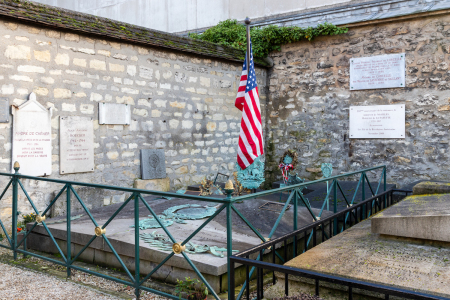Postcard from Paris: An overlooked and forgotten national hero

Largely overlooked in Paris, a city full of landmarks and other sights popular with tourists, is the grave of the Marquis de Lafayette.
Not only did Marie Joseph Yves Roches Gilbert du Motier serve in the Continental Army under George Washington and help secure the Franco-American alliance that changed the trajectory of the Revolutionary War, but he wrote the Declaration of the Rights of Man and of the Citizen at the start of the French Revolution in 1789. The seminal document, inspired by the Enlightenment and the principles embodied by America’s founding documents, remains a foundation of the French Republic to this very day.
Despite this incredible legacy, Lafayette seems forgotten today. Sure, the whitewashing of the great men from past eras by woke iconoclasts can be blamed but it is also undeniable that schools long ago stopped teaching history.
Lafayette’s final resting place is Picpus Cemetery, a private cemetery on the grounds of a former Roman Catholic convent. His grave is surrounded by others, including mass graves containing 1,306 victims of the guillotine during the Reign of Terror in 1794.
Absent an American flag and several plaques, the grave is remarkably humble and seems beneath the dignity of a major national hero of both France and the United States.

The flag and most of the plaques date to July 4, 1917, when the American Expeditionary Forces under famed Gen. John Pershing arrived in Paris not long after the United States entered World War I or the Great War.
Pershing’s soldiers paraded through the city with great fanfare. Not only was it Independence Day for the doughboys, but the occasion was also steeped in the symbolism of the United States rescuing France just as Lafayette and the French came to the aid of the American cause.
The parade ceremonially ended at the cemetery, where Pershing, accompanied by French dignitaries, paid homage to Lafayette with Col. Charles Stanton — speaking for the Americans — famously declaring, “Lafayette, we are here.”
Today, the American flag is replaced during a graveside ceremony every July 4.
If you go
Picpus Cemetery (in French, Cimetiere de Picpus) is open from 2 p.m. to 5 p.m. Monday to Saturday. Access is through a somewhat nondescript door at 35 Rue de Picpus.
Supposedly, a nominal admission fee of €2 (about $2.28 at the time of writing) is charged but there was nobody collecting it when this columnist visited.
Dennis Lennox writes a travel column for The Christian Post.
Dennis Lennox writes about travel, politics and religious affairs. He has been published in the Financial Times, Independent, The Detroit News, Toronto Sun and other publications. Follow @dennislennox on Twitter.





















